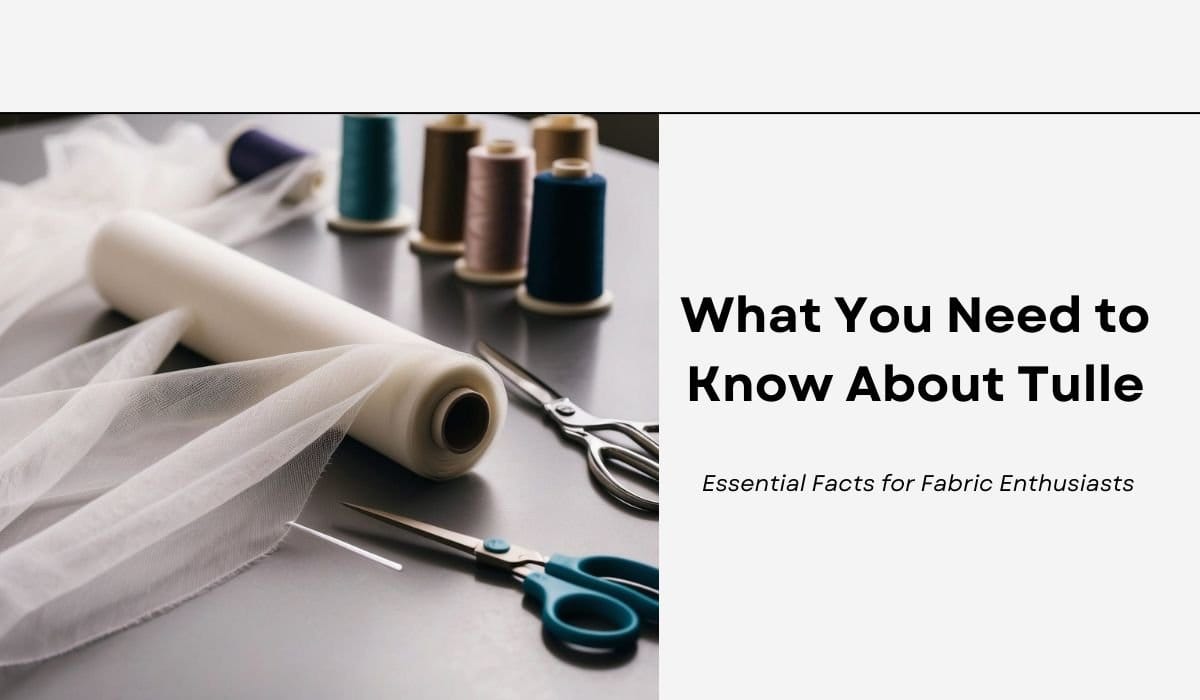From Ballet to Bridal: Understanding the Magic and Mechanics of Fashion’s Most Ethereal Fabric
Tulle, a delicate and versatile fabric, has captured the hearts of designers and crafters alike. This lightweight, netted material is known for its ethereal quality and ability to add volume and elegance to various creations. Tulle fabric is made from fine, tightly woven netting that creates a transparent, airy texture.
From bridal veils to ballet tutus, tulle has found its place in both the fashion industry and the world of crafting. Its unique properties make it an ideal choice for adding flair to dresses, skirts, and decorative items. Tulle’s popularity stems from its ability to create dramatic effects while maintaining a lightweight feel.
When working with tulle, it’s important to consider its delicate nature. Sharp needles and gentle handling are essential to prevent snags and tears. Whether you’re a seasoned seamstress or a DIY enthusiast, understanding the characteristics of tulle will help you make the most of this enchanting fabric.
On This Page
Key Takeaways
- Tulle is a sheer, netted fabric that adds volume and elegance to various designs
- The fabric requires careful handling and specific sewing techniques to prevent damage
- Tulle is widely used in fashion, crafting, and decorative applications due to its versatility
Historical Context of Tulle

Tulle fabric has a rich history spanning centuries. It emerged as a delicate netting material and quickly became a staple in fashion and performance arts.
Evolution and Origins
Tulle fabric originated in the 18th century. It was named after the French city of Tulle, known for its lace production. At first, tulle was made by hand using methods like lace-making.
In 1768, tulle production took a leap forward. The first machine-made netting was created in Nottingham, England. This innovation sped up the process significantly.
The French city of Tulle started machine production in 1817. This was helped by the invention of the bobbinet machine in 1806. These advances made tulle more accessible and affordable.
Tulle in Fashion History
Tulle gained popularity in the 19th century. It became a symbol of elegance and grace. Queen Victoria’s wedding gown in 1840 featured tulle, boosting its status.
Ballet tutus made of tulle became iconic. They allowed dancers to move freely while creating a dreamy effect. This cemented tulle’s place in performance arts.
In haute couture, designers embraced tulle for its versatility. It was used in veils, gowns, and decorative elements. The fabric’s delicate netting added texture and volume to garments.
By the 20th century, tulle was a fashion staple. It appeared in wedding dresses, formal wear, and everyday clothing. Its popularity continues today, with designers finding new ways to use this timeless fabric.
Types of Tulle and Their Properties
Tulle comes in various materials and styles, each with unique qualities. These different types offer a range of options for crafting, fashion, and décor. The material and manufacturing process affect the tulle’s appearance, durability, and feel.
Silk Tulle Varieties
Silk tulle is prized for its luxurious feel and delicate appearance. French silk tulle is known for its fine, soft texture and subtle sheen. It’s often used in high-end bridal veils and gowns. English silk tulle has a slightly stiffer hand and more defined holes, making it ideal for structured garments.
Italian silk tulle is coarser than its French or English counterparts. It’s more durable and holds its shape well, making it suitable for fuller skirts and decorative elements. Silk tulle varieties are generally more expensive but offer unmatched elegance and drape.
Nylon and Polyester Tulle
Synthetic tulles are more affordable and widely available. Nylon tulle is soft, lightweight, and has a slight sheen. It’s popular for tutus, veils, and craft projects. Polyester tulle is stronger than silk and cotton, making it ideal for items that need durability.
Illusion tulle, often made from nylon or polyester, has a very fine mesh. It’s commonly used for bridal veils and as an overlay on dresses. Synthetic tulles come in a wide range of colours and are easier to care for than silk varieties.
Specialty Tulles
Stretch tulle contains elastane fibres, giving it flexibility and a form-fitting quality. It’s excellent for dancewear and body-hugging garments. Soft tulle has a more pliable texture, achieved through special finishing processes.
Glitter or metallic tulle incorporates shimmering elements for a sparkly effect. It’s popular for costume design and festive décor. Some specialty tulles feature embroidery or printed patterns, adding visual interest to the fabric’s inherent texture.
Tulle in Apparel
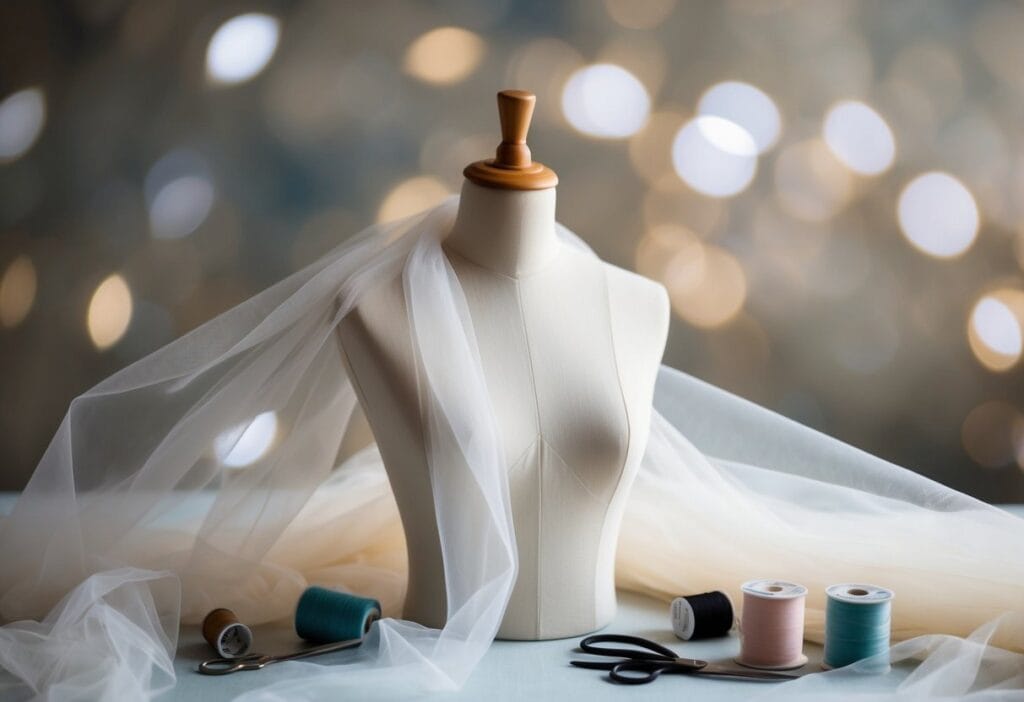
Tulle fabric plays a starring role in many types of clothing and costumes. Its light, airy qualities and ability to create volume make it ideal for special occasion wear and dance attire.
Bridal and Evening Wear
Tulle fabric is a top choice for bridal and formal wear. Many wedding dresses feature layers of tulle to create a full, romantic silhouette. Bridal veils often use soft tulle for a dreamy, floating effect.
Evening gowns incorporate tulle to add drama and movement. Designers use it for voluminous skirts or as an overlay to create texture.
Some lingerie pieces use fine tulle for a delicate, sheer look. Party dresses may have tulle underskirts or overlays for a fun, flouncy style.
Costumes and Dance Attire
Ballet costumes rely heavily on tulle. The classic ballerina tutu is made from stiff tulle to hold its iconic shape. Tulle creates the ethereal look of a dancer in motion.
Many other dance costumes use tulle for its lightweight properties and ability to float gracefully. Theatre productions often feature tulle in fairy or ghost costumes.
Halloween and fancy dress outfits frequently incorporate tulle to create whimsical or magical effects. Its versatility allows for creative costume design.
Everyday Clothing Innovations
Tulle is finding its way into everyday fashion. Designers use it as an accent in casual dresses or tops for a touch of femininity.
Some sportswear brands experiment with tulle in athletic gear for improved ventilation. Layering tulle under skirts adds volume without bulk.
Accessories like scarves and hair decorations use tulle for a light, airy look. Its durability makes it suitable for repeated wear in daily outfits.
Tulle in Crafting and Decor
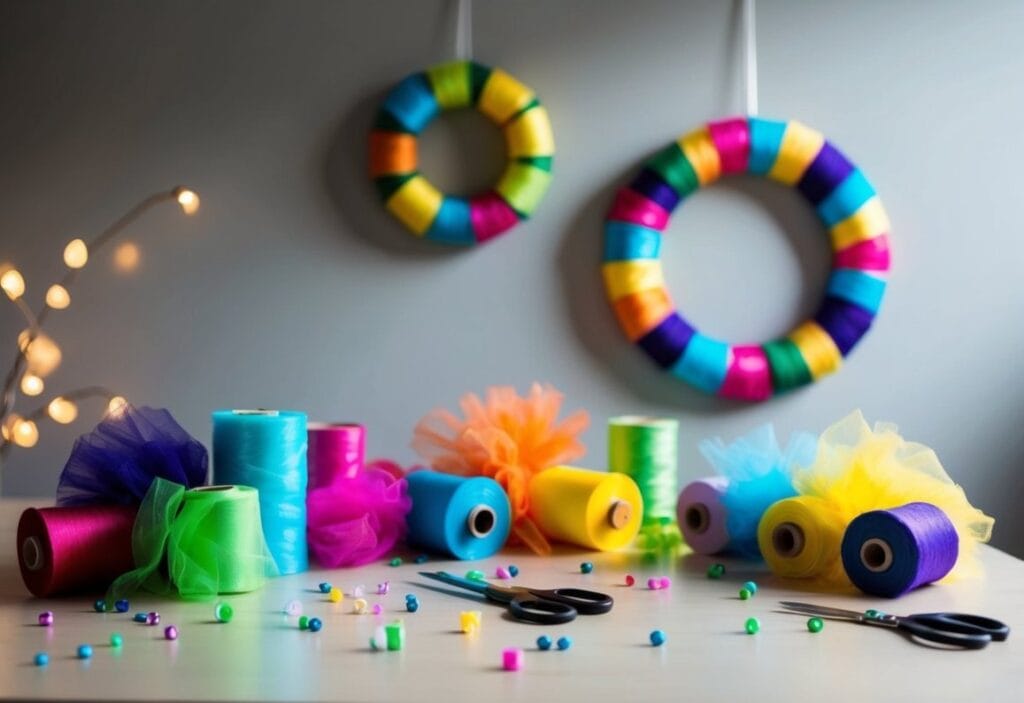
Tulle fabric adds an elegant touch to crafts and home decor. Its versatility allows for creative applications in various settings and projects.
Home Decoration Applications
Tulle transforms living spaces with its airy texture. Drape it over windows for a soft, diffused light effect. Create romantic bed canopies or wrap it around lamp shades for a dreamy glow. Tulle fabric can enhance home decor by adding a delicate ambiance to any room.
Use tulle to craft ethereal table runners or tie bows on chair backs for a touch of whimsy. It’s perfect for creating lightweight curtains that allow natural light to filter through.
For a unique wall decoration, layer tulle in different colours to create a gradient effect or use it as a backdrop for framed artwork.
Event Theming and Floral Embellishments
Tulle is a staple in event decorations. It’s ideal for crafting pew bows, wrapping centrepieces, or draping over arches. The fabric’s versatility shines in both indoor and outdoor settings.
For floral arrangements, tulle adds volume and softness. Wrap bouquets in tulle for a classic bridal look or use it to create fabric flowers for long-lasting decorations.
In party decor, tulle balloons create a magical atmosphere. Tie tulle bows around cutlery or napkins for an elegant table setting. Its translucent nature makes it perfect for layering with other fabrics to achieve depth and texture in event spaces.
DIY Projects and Handicrafts
Tulle lends itself to numerous DIY craft projects. Create tutus, pom-poms, or decorative garlands with ease. Its stiffness makes it ideal for maintaining shape in three-dimensional crafts.
Craft enthusiasts use tulle to make delicate hair accessories, such as fascinators or flower crowns. It’s also excellent for creating costume elements like fairy wings or ghost costumes.
For gift wrapping, tulle adds a luxurious touch. Use it to make gift bags or as an alternative to traditional ribbon. Tulle can also be used in scrapbooking or card making for a textured, layered effect.
Working with Tulle Fabric
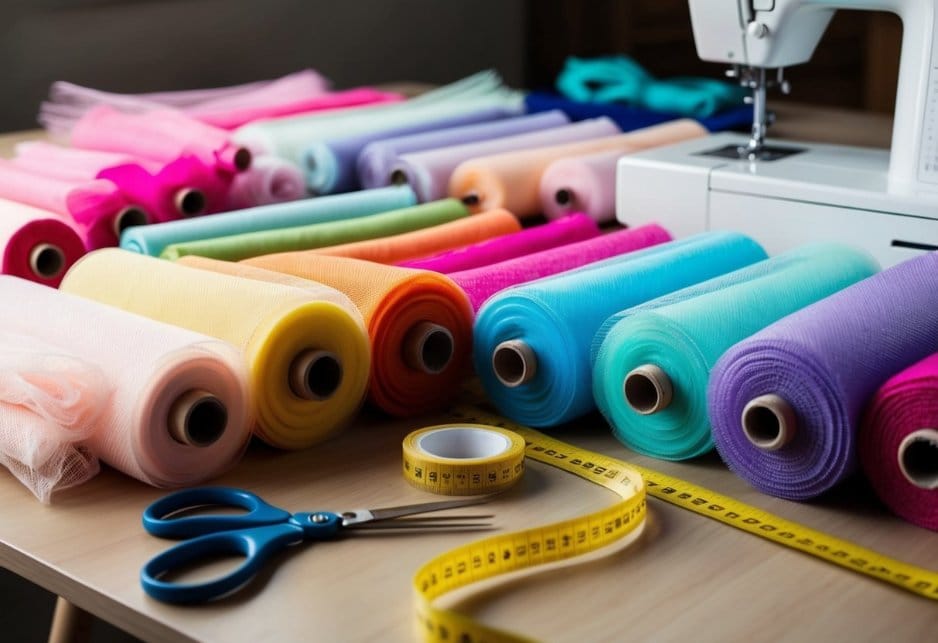
Tulle is a versatile fabric that requires special techniques and care. Sewing, shaping, and decorating tulle can create stunning effects for various projects.
Sewing Techniques
Sewing with tulle requires patience and precision. Use a fine needle and lightweight thread to prevent damage to the delicate mesh. A zigzag stitch works well for joining tulle pieces, as it allows for flexibility and prevents fraying.
French seams are ideal for creating clean, finished edges on tulle garments. To execute this technique, sew the wrong sides together first, trim the seam, then fold and sew the right sides together.
When working with multiple layers of tulle, pin carefully to avoid snagging. Tissue paper placed between the tulle and the sewing machine can help prevent the fabric from being pulled into the feed dogs.
Creating Shapes and Structures
Tulle’s hexagonal mesh pattern allows for unique shaping possibilities. To create volume, gather multiple layers of tulle at the waist or neckline of a garment.
For structured pieces like tutus or petticoats, use a stiffer tulle or layer it with crinoline fabric. Crinoline provides additional support and helps maintain shape.
To create rounded edges, fold the tulle and stitch along the curve. Trim excess fabric close to the stitching line, being careful not to cut into the seam.
Decorative Stitching
Embellishing tulle adds texture and visual interest. Use a tear-away stabiliser under the tulle when adding embroidery or appliqué to prevent puckering and ensure smooth stitching.
Beading can be sewn onto tulle by hand or machine. For machine beading, use a special beading foot and adjust tension settings to accommodate the beads.
Layering different colours of tulle can create depth and dimension. Experiment with contrasting or complementary shades to achieve unique effects for special occasion wear or home decor projects.
Care and Maintenance of Tulle
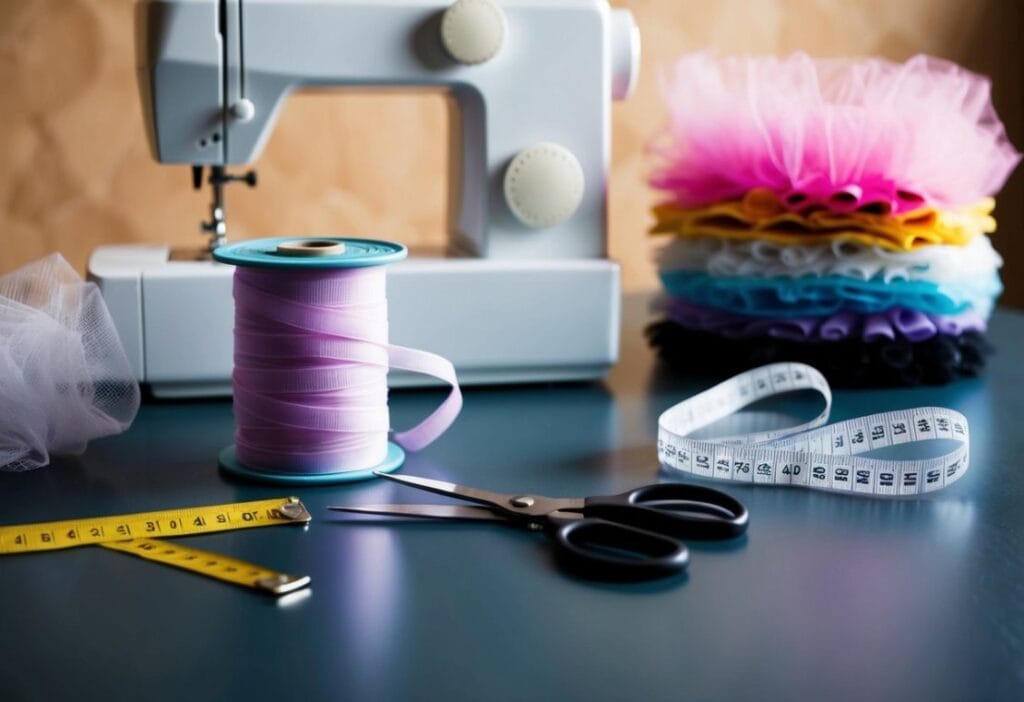
Proper care keeps tulle looking its best. Regular cleaning, careful storage, and timely repairs help maintain this delicate fabric’s beauty and extend its life.
Cleaning Guidelines
Washing tulle requires gentle handling. Use cold water and mild detergent to clean tulle by hand. Avoid wringing or twisting the fabric, as this can damage its structure.
For tougher stains, spot-clean with a soft brush. Rinse thoroughly and let the tulle air dry flat.
Steam cleaning is an effective way to freshen tulle and remove wrinkles. Hold the steamer a few inches away to prevent damage.
Professional dry cleaning is recommended for embellished or heavily soiled tulle items. Always inform the cleaner about the fabric’s delicate nature.
Storage Solutions
Proper storage is crucial for maintaining tulle’s shape and texture. Store tulle items in a cool, dry place away from direct sunlight.
Hang tulle dresses or skirts on padded hangers to prevent creasing. For smaller pieces, roll them gently in acid-free tissue paper before placing in a breathable garment bag.
Avoid folding tulle if possible, as creases can be difficult to remove. If folding is necessary, use tissue paper between layers to reduce friction.
Keep tulle away from rough surfaces or sharp objects that could snag the delicate netting.
Repairing Damages
Small tears in tulle can often be mended at home. Use a fine needle and thread that matches the tulle’s colour. Stitch carefully, following the fabric’s mesh pattern.
For larger holes, patch the area with a piece of matching tulle. Secure it with tiny, evenly spaced stitches around the edges.
Loose beads or sequins can be reattached using a fine needle and strong thread. Take care not to pull too tightly, which could pucker the fabric.
If repairs seem too complex, seek help from a professional seamstress experienced in working with delicate fabrics.
Choosing the Right Tulle for Your Needs
Tulle comes in many varieties, each suited for different uses. Picking the proper type depends on your project, quality needs, and budget. Let’s explore how to select the best tulle for your needs.
Comparing Tulle Qualities
Tulle fabric quality affects its look and feel. Soft bridal tulle is ideal for elegant wedding gowns and veils. Stiffer nylon tulle works well for crafts and decorations.
Nylon tulle is strong and affordable. It holds its shape well, making it great for tutus and petticoats.
Silk tulle is luxurious but pricey. It drapes beautifully for high-end bridal wear.
Polyester tulle balances cost and quality. It’s versatile for many projects.
Consider these factors when comparing:
- Softness
- Stiffness
- Durability
- Sheen
- Cost
Selecting by Application
For wedding gowns, choose soft, flowing tulle. It creates an ethereal look perfect for veils and skirts.
Stiffer tulle works best for structured pieces like petticoats. It adds volume without weighing down the garment.
Craft projects often use budget-friendly nylon or polyester tulle. These hold up well to handling and shaping.
For tutus and ballet costumes, pick a tulle with good “bounce”. This helps maintain the classic tutu shape.
Printed tulle adds visual interest to garments and decor. It’s great for overlays and accents.
Buying Tips and Tricks
Buy tulle from reputable fabric shops for the best quality. Feel the tulle before purchasing if possible.
Compare prices between shops. Buying in bulk often saves money for large projects.
Check the tulle’s width. Wider tulle means fewer seams in your finished product.
Ask for samples before making a big purchase. This lets you test the tulle’s qualities at home.
Store tulle properly to prevent damage:
- Keep it clean and dry
- Store rolls upright
- Use garment bags for protection
Consider the season when choosing tulle. Lighter types work well for summer, while heavier tulles suit winter wear.
Sustainability and Future of Tulle
Tulle’s sustainability is a growing concern in fashion. Traditional tulle fabrics like nylon and polyester are not eco-friendly. They come from non-renewable resources and don’t break down easily.
Silk tulle is a more natural option. It’s biodegradable but can be costly. Cotton tulle offers another earth-friendly choice. It’s breathable and breaks down over time.
Designers are looking for greener ways to make tulle. Some are using recycled fibres to create this airy fabric. Others are exploring plant-based materials.
The future of tulle may lie in new blends. These could mix the best qualities of different materials. For example, a mix of cotton and recycled polyester might offer both sustainability and durability.
Italian and English tulle are known for their quality. These regions are working on more sustainable production methods. They aim to keep their reputation while reducing environmental impact.
Tulle’s sheer nature makes it perfect for formal gowns. As consumers demand greener options, designers are rising to the challenge. They’re creating stunning, eco-friendly dresses without losing tulle’s magic.
The fashion industry is pushing for change. New tech and creative thinking are shaping tulle’s future. The goal is to keep its beauty while making it kinder to our planet.
Frequently Asked Questions
Tulle is a unique fabric with distinct properties and uses. It requires special care and handling. Let’s explore some common questions about tulle.
What distinguishes tulle from other types of fabric?
Tulle is a lightweight, sheer fabric with a fine mesh structure. It has small, hexagonal holes that give it a net-like appearance.
Tulle holds its shape well while remaining flexible. This makes it ideal for creating volume in garments.
In what ways is tulle typically utilised in fashion and design?
Tulle is often used in wedding gowns and formal wear to add fullness and drama. It’s a popular choice for veils, underskirts, and decorative overlays.
In dance costumes, tulle creates the iconic tutu. It’s also used in home decor for curtains and decorative accents.
What are the common pitfalls when working with tulle material?
Tulle can be tricky to sew due to its delicate nature. It snags easily on rough surfaces and can unravel if not handled carefully.
Using clips instead of pins when sewing tulle can help prevent snags. Sharp, fine needles are essential to avoid damaging the fabric.
How can one effectively care for and maintain tulle garments?
Tulle requires gentle handling to maintain its shape and appearance. Hand washing in cool water with mild detergent is often best.
Avoid wringing or twisting tulle. Instead, gently squeeze out excess water and lay flat to dry. Store tulle items away from rough surfaces to prevent snags.
What should be considered when selecting tulle for specific projects?
The type of tulle chosen depends on the project. Silk tulle is soft and delicate, perfect for high-end garments. Nylon tulle is more durable and suitable for costumes.
Consider the desired stiffness and drape. Some tulles are stiffer, ideal for structured pieces, while others are softer for a flowing effect.
Can tulle be recycled or repurposed, and if so, how?
Tulle can be repurposed in various craft projects. It can be used to make decorative bows, flowers, or pom-poms.
Old tulle garments can be cut into strips for use in rag rugs or as stuffing for cushions. However, tulle is not commonly recycled through standard recycling programmes.
Related Post: Fabric 101: Essential Guide to Textiles and Materials

